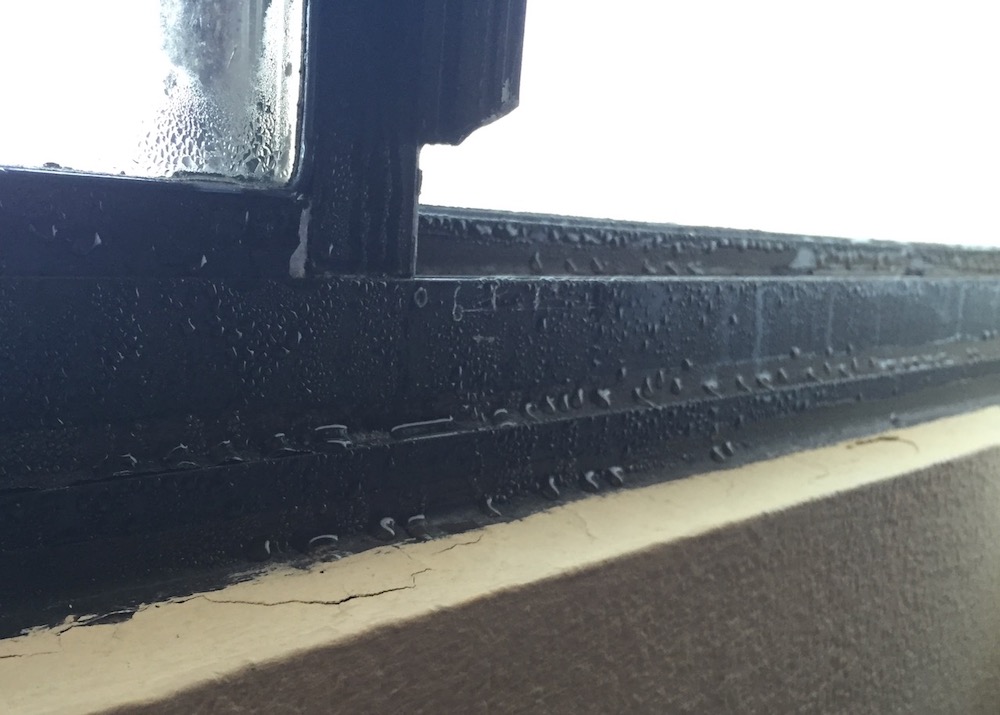Five Fun Facts About Dew Point Temperature

The humidity is returning for the summer here in the southeastern US. And as you may know, I don’t use relative humidity to gauge how humid the outdoor air is. Why? For starters, the humidity can get up to 100% even on a cold day so how does knowing only that metric help?
Many people get confused on this matter, saying things like, “It gets up to 98 °F and 95% relative humidity where I live.” Maybe, but almost certainly those two things don’t happen at the same time. If they did, they’d have a new world record for dew point temperature.
Anyway, here are a few fun facts about the dew point temperature.
1. Under normal conditions* here on the surface of Earth, the dew point temperature cannot be higher than the air temperature (dry bulb). That puts a cap on your maximum dew point. So if you wake up and the outdoor temperature is 59 °F (15 °C), you know the maximum dew point.
2. When the dew point and dry bulb temperatures are equal, the relative humidity is 100%.
3. Standard indoor design conditions from the Air Conditioning Contractors of America (ACCA) are 75 °F (24 °C) and 50% relative humidity. Thus, the dew point temperature for indoor air at those conditions is 55 °F (13 °C).
4. Psychrometric calculators are available as apps for your smart phone to let you find the dew point temperature for any dry bulb temperature and relative humidity. I use one called PsychroApp.
5. Here’s my rough guide for the dew point temperature’s impact on comfort when you’re outdoors in summer:
A. Dew point less than 60 °F (~15 °C) ⇨ comfortable
B. Dew point in the 60s Fahrenheit (~15-20 °C) ⇨ moderately comfortable
C. Dew point higher than 70 °F (21 °C) ⇨ uncomfortable

The dew point temperature here in Atlanta this morning is 66 °F (19 °C). We’re definitely feeling the humidity now. I called that moderately comfortable above, but the more active you are, the less comfortable it feels. And I’ve got to get out and mow the yard later today because my wife didn’t like my idea of continuing No Mow May with Just Grow It June.
Post script This is article number 1,000 in the Energy Vanguard Blog! I published my first article on 7 March 2010.
Allison A. Bailes III, PhD is a speaker, writer, building science consultant, and the founder of Energy Vanguard in Decatur, Georgia. He has a doctorate in physics and writes the Energy Vanguard Blog. He also has a book on building science coming out in the fall of 2022. You can follow him on Twitter at @EnergyVanguard.
* Abnormal conditions would be supersaturation, as can happen high in the atmosphere. The dew point can go higher than the dry bulb temperature—and the humidity higher than 100%—when there are no particles or surfaces for the water vapor to condense on…until a plane goes by.
Related Articles
Make Dew Point Your Friend for Humidity
The Problem with Relative Humidity
Can an Exhaust Fan Control Humidity in a Spray Foam Attic?
Comments are moderated. Your comment will not appear below until approved.
This Post Has 13 Comments
Comments are closed.

If air is below 32 F dry-bulb, does it have a dew-point or a frost-point 😉
RoyC, yes, it does. And which one it has depends on the pressure. 🤪
I guess that the air could be above 32 F and still have a “frost-point” if the humidity is low enough. But I have never heard anyone make this distinction.
But this got me wondering about wet-bulb temperature. The ASHRAE Fundamentals Handbook does define wet-bulb (liquid water on the wick) separately from ice-bulb because it is calculated differently due to the difference between the heat of vaporization and heat of sublimation of water. In fact, there are conditions near freezing where both can exist. Is that a fun fact, or did I steal your next column?
RoyC in New England we occasionally get frost on roofs (houses & cars) overnight in the fall even when the measured air temperature never dropped below freezing. Perhaps not quite the same as your “frost point” but kinda similar due in part to radiational (super) cooling.
BrianR, you mean like this:
Why Doesn’t Frost Form in the Carport?
Yep, learned this the hard way as a young boy scout sleeping under the stars!
The issue of “frost point” is quite relevant to heat pump operation during cold(er) weather. Those of us in the southeast have used heat pumps for decades, but advances in heat pump technology, sky-high nat gas prices, and the push to decarbonize homes has suddenly made much of the rest of the planet much more interested in heat pumps.
A key element of both the efficiency and reliability of heat pumps is managing frequency and duration of defrost cycles. That in turn depends very much on ambient outdoor frost point. A poorly selected or installed heat pump can get hammered by icing during cold rainy weather – defrost capability overwhelmed by rainfall.
So I don’t know if this anything to do with dew point, but I think maybe could be a topic for a public service announcement for your readers. I just had my roof replaced and
the contractors basically didn’t even cut any opening for the new ridge vents they installed. Luckily I had not paid them all their money yet and I made him come back out and fix it. Supposedly these guys are professionals, but you’d think they would know how to install a ridge vent. Now since they cut it I noticed it appears to be twice the size of what the manufacturer recommends for the opening. I guess now the question is how big can the opening be without causing an issue?
The Economist has an article on the dangers of 35 degree Celcius wet bulb temps. Scary to think of a country like India being affected by something like this. https://www.economist.com/graphic-detail/2022/05/13/heat-and-humidity-are-putting-millions-of-indians-in-peril
I thoroughly enjoy your writings. Congrats EVB for hitting the 1,000-article mark!
Glad you brought this up. Will using the dew point be more useful than relative humidity in some case for building science too? I need to figure out the best practice for my house to balance the need to lower CO2 levels in the house and the relative humidity introduced in the house when I open the windows in the morning. (I have an ERV which never worked for many reasons.) Is the dew point a more useful number to relate to what the relative humidity will be as the house warms up during the day? There was a big difference in the RH jump in the house from the mornings when it was 57 degrees outside and this morning at 64 degrees- the house RH went up to 70%. I’m banking on the fact that that the RH should go down as the house warms up during the day, plus I don’t run the air conditioning until the house gets to 78 degrees to be safe for the house.
I know RH is used by the industry for reference on what will and won’t harm buildings, but I wonder if it will be more accurate to develop more guidance that covers the “it depends” aspects, as you do in the Energy Vanguard. For instance, if my house gets to 70% as I did this morning, and then I used the AC to bring the house to 65 degrees, I think I would cause a problem if my understanding of the science is right. I know some folks don’t want to deal with details, but for me as a homeowner trying to figure things out, the “it depends” details sure help.
Dewpoint is extremely useful, in fact vital to understanding how building assemblies perform as to resisting moisture problems / failures.
In general, it is a bad idea to cool the interior of a home (or any building) below the outdoor air dewpoint, especially if it is a conventionally stick framed structure. Overcooling invites uncontrolled moisture formation within exterior (and sometimes even interior) wall and upper story floor support assemblies as well as condensation / insulation failures of oh-so-common attic ductwork.
Given rising dewpoints owing to climate change, my stance on setpoint vs dewpoint has come under increasing pressure as I enter my 4th decade living in the humid southeast.
I recommend cooling setpoints no lower than 75*F, ideally 77-78*F and strive to provide HVAC systems and building science testing / upgrades that drive comfort at those temperatures…in a nutshell that means much better humidity control via both HVAC equipment selection and improving how the structure performs as to infiltration.
72*F is my absolute lowest allowable cooling setpoint, and that preferably only intermittently, such as at night. Any customer / client that wants to cool their home to sixty-anything degrees becomes an ex-customer / client ASAP…let someone else die taking that mold litigation hill!
If a structure must be routinely cooled below outdoor dewpoint there are assemblies that tolerate that…my personal favorite is ICF (Insulated Concrete Form) walls with closed cell spray foam insulation under roof sheathing with everything blower door verified substantially airtight before drywall goes up. In other words bury the dewpoint temperature within vapor impermeable exterior wall and ceiling / attic assemblies verified to be substantially airtight.
Thanks, that is very helpful.